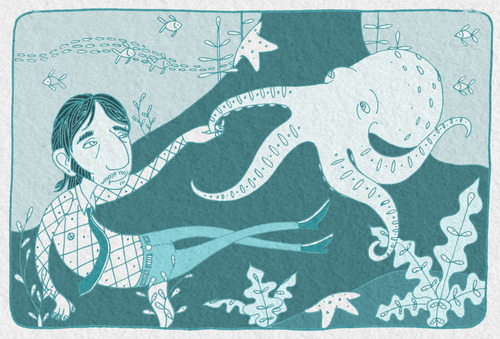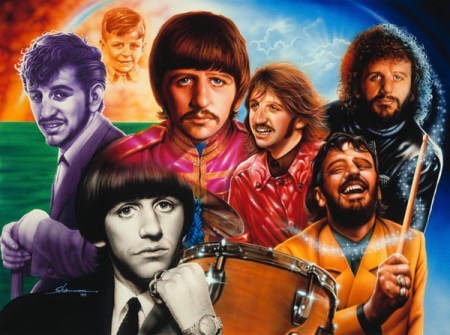It has been repeatedly told that the men behind the most successful writing partnership, John Lennon and Paul McCartney, often dismissed Ringo Starr's songs. Though it was a popular joke among Beatles fans, there are no actual records to prove Ringo's rejection by John and Paul. But it may actually have a grain of truth since only two songs of Ringo Starr were included in the albums of The Beatles.
Between those two songs of Ringo, one stood out as my personal favorite - Octopus's Garden. It is the song written by Ringo Starr (published under his real name Richard Starkey) from their 1969 album Abbey Road. though I am a big fan of the songs of John Lennon and Paul McCartney, there is something with this song, something cosmic, upbeat, and lively beat even though it deals with an underwater creature and not the usual Beatle theme about love, life, and friendship.
The Quiet Beatle, George Harrison, helped Ringo with this song. George said that is is a song by Ringo and I quote: "Octopus's Garden is Ringo's song. It's only the second song Ringo has ever written, mind you, and it's lovely."

Ringo Starr shared how he was able to write this magnificent song:
I wrote Octopus’s Garden in Sardinia. Peter Sellers had lent us his yacht and we went out for the day… I stayed out on deck with [the captain] and we talked about octopuses. He told me that they hang out in their caves and they go around the seabed finding shiny stones and tin cans and bottles to put in front of their cave like a garden. I thought this was fabulous, because at the time I just wanted to be under the sea too. A couple of tokes later with the guitar - and we had Octopus’s Garden! (Beatles Bible)
And today, the whole world (or maybe the Beatle world) is celebrating the 72nd birthday of the man behind the Octopus, the one quarter of The Beatles, Ringo Starr. Ringgo may be considered by some as the luckiest no-talent in the history of music but that will not change the face that he is the drummer of The Beatles.

No-talent? How come? Let me share with you one of the best piece describing Ringo Starr's incomparable talent. It is entitled Thirteen Reasons to Give Ringo Starr Some Respect by John Bryant.
Ringo Starr, the luckiest no-talent on earth. All he had to do was smile and bob his head. Oh yes, and keep a beat for three of the most talented musicians/songwriters of this century. What other impression could one have when judging the role that Ringo played in the success of the Beatles? Did Ringo really make a difference? Upon listening to the latest release by The Beatles, Anthology 1, you get a chance to listen to Pete Best and two other drummers play on over twenty songs. Was Ringo simply in the right place at the right time? The following items may help in going beyond the image:
- Ringo was the first true rock drummer to be seen on TV. All the Rock & Roll drummers featured with Elvis, Bill Haley, Little Richard, Fats Domino and Jerry Lee Lewis were mostly R&B drummers that were making the transition from a swing drumming style of the 40’s and 50’s toward the louder and more “rocking” sound that is associated with “I Want To Hold Your Hand”. They were dressed in tuxedos and suits and held the drumsticks in the “traditional” manner of military, orchestra, and jazz drummers. Ringo showed the world that power was needed to put the emphasis on the “rock” in Rock & Roll music, so he gripped both sticks like hammers and proceeded to build a foundation for rock music.
- Ringo changed the way drummers hold their sticks by making popular the “matched” grip of holding drumsticks. Nearly all drummers in the Western World prior to Ringo held their sticks in what is termed the “traditional” grip, with the left hand stick held like a chopstick. This grip was originally developed by military drummers to accommodate the angle of the drum when strapped over the shoulder. Ringo’s grip changes the odd left hand to match the right hand, so that both sticks are held like a flyswatter. Rock drummers along with marching band and orchestral percussionists now mostly play with a “matched” grip, and drum companies have developed straps and accessories to accommodate them.
- Ringo started a trend of placing drummers on high risers so that they would be as visible as the other musicians. When Ringo appeared on the Ed Sullivan Show in 1964, he immediately caught the attention of thousands of “drummers to be” by towering over the other three Beatles. Elvis’s drummer was looking at a collection of backs
- These same “wannabe” drummers also noticed that Ringo was playing Ludwig drums and they immediately went out and bought thousands of these drumsets, thus establishing Ludwig as the definitive name in Rock & Roll drums at that time.
- Ringo changed the sound of recorded drums. About the time of Rubber Soul (released Dec. 6,1965), the sound of the drumset started to become more distinct. Along with help from the engineers at Abbey Road studios, Ringo popularized a new sound for the drums by tuning them lower, deadening the tonal ring with muffling materials, and making them sound “closer” by putting a microphone on each drum.
- Ringo has nearly perfect tempo. This allowed the Beatles to record a song 50 or 60 times, and then be able to edit together different parts of numerous takes of the same song for the best possible version. Today an electronic metronome is used for the same purpose, but the Beatles had to depend on Ringo to keep the tempo consistent throughout the dozens of takes of the songs that you know and love so well. Had he not had this ability, the Beatles recordings would sound completely different today.
- Ringo’s “feel” for the beat serves as a standard for pop-rock record producers and drummers alike. It is relaxed, but never dragging. Solid, yet always breathing. And yes, there is a great amount of musical taste in his decisions of what to play and when to play it. In most recording sessions, the drummer’s performance acts as a barometer for the rest of the musicians. The stylistic direction, dynamics, and emotions are filtered through the drummer. He is the catcher to whom the pitcher/songwriter is throwing. If the drumming doesn’t feel good, the performance of any additional musicians is doomed from the start. The Beatles rarely if ever had this problem with Ringo.
- Ringo hated drum solos, which should win points with quite a few people. He only took one solo while with the Beatles. His eight measure solo appears during “The End” on the “B” side of Abbey Road. Some might say that it is not a great display of technical virtuosity, but they would be at least partially mistaken. You can set an electronic metronome to a perfect 126 beats per minute, then play it along with Ringo’s solo and the two will stay exactly together.
- Ringo’s ability to play odd time signatures helped to push popular songwriting into uncharted areas. Two examples are “All you Need is Love” in 7/4 time, and “Here Comes the Sun” with repeating 11/8, 4/4, and 7/8 passages in the chorus.
- Ringo’s proficiency in many different styles such as two beat swing (“When I’m Sixty-Four”), ballads (“Something”), R&B (“Leave My Kitten Alone” and “Taxman”) and country (the Rubber Soul album) helped the Beatles to explore many musical directions with ease. His pre-Beatle experience as a versatile and hard working nightclub musician served him well.
- The idea that Ringo was a lucky Johnny-on-the-spot-with-a-showbiz-stage-name is wrong. In fact, when Beatles producer George Martin expressed his unhappiness after the first session with original drummer Pete Best, the decision was made by Paul, George, and John to hire who they considered to be the best drummer in Liverpool - Ringo Starr. His personality was a bonus.
- The rumors that Ringo did not play on many of the Beatles songs because he was not good enough are also false. In fact, he played on every released Beatles recording (not including Anthology 1) that include drums except for the following: “Back In The USSR” and “Dear Prudence”, on which Paul played drums due to Ringo temporarily quitting the band, “The Ballad of John and Yoko”, again featuring Paul on drums because Ringo was off making a movie, and a 1962 release of “Love Me Do” featuring session drummer Andy White.
- When the Beatles broke up and they were all trying to get away from each other, John Lennon chose Ringo to play drums on his first solo record. As John once said, “If I get a thing going Ringo knows where to go, just like that..” A great songwriter could ask no more of a drummer. Except maybe to smile and bob his head.
He may not be my favorite Beatle (of course, it will always be John Lennon), He may have written only two Beatle songs compared to the hundreds by Lennon and McCartney, but he will always be the best and respected drummer.
Happy 72nd birthday. Ringo. Thank you for the music. Thank you for bringing us to the octopus's garden. I will always be a fan.
Elsewhere:
- Octopus's Garden (Live) - I was browsing Beatles songs on YouTube when I came across this video. this was performed in 2005 - thirty-six (36) years after it was recorded. There is not much difference between the original recording and this live version. Just, wow. I have nothing bus respect to Richard Starkey.
Photo sources: Octopus's Garden by Loris Lora and the Seven Faces of Ringo courtesy of Shannon McDonald.
No comments:
Post a Comment